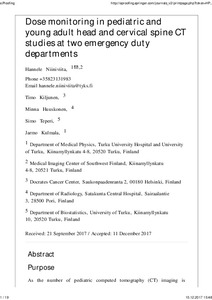Dose monitoring in pediatric and young adult head and cervical spine CT studies at two emergency duty departments
Simo Teperi; Timo Kiljunen; Jarmo Kulmala; Hannele Niiniviita; Minna Huuskonen
https://urn.fi/URN:NBN:fi-fe2021042717984
Tiivistelmä
Purpose
As the number of pediatric computed tomography (CT) imaging is increasing, there is a need for real-time radiation dose monitoring and evaluation of the imaging protocols. The aim of this study was to present the imaging data, patient doses, and observations of pediatric and young adult trauma—and routine head CT and cervical spine CT collected by a dose monitoring software.
Methods
Patient age, study date, imaging parameters, and patient dose as volume CT dose index (CTDIvol) and dose length product (DLP) were collected from two emergency departments’ CT scanners for 2-year period. The patients were divided into four age groups (0–5, 6–10, 11–15, and 16–20 years) for statistical analysis and effective dose determination. The 75th percentile doses were evaluated to be used as local diagnostic reference levels (DRLs).
Results
Six hundred fifteen trauma head, 318 routine head, and 592 trauma cervical spine CT studies were assessed. All mean CTDIvol values were statistically lower in hospital B (40.3 ± 12.3, 30.03 ± 11.1, and 6.9 ± 3.1 mGy, respectively) than in hospital A (53.0 ± 12.9, 43.2 ± 8.7, and 18.3 ± 7.3 mGy, respectively). Statistically significant differences were observed on scanning length between hospitals and between CTDIvol values when protocol was updated. The 75th percentiles of trauma cervical spine in hospital B can be used as local DRL. Non-optimized protocols were also revealed in hospital A.
Conclusion
Dose monitoring software offers a valuable tool for evaluating the imaging practices and finding non-optimized protocols.
Kokoelmat
- Rinnakkaistallenteet [19218]
